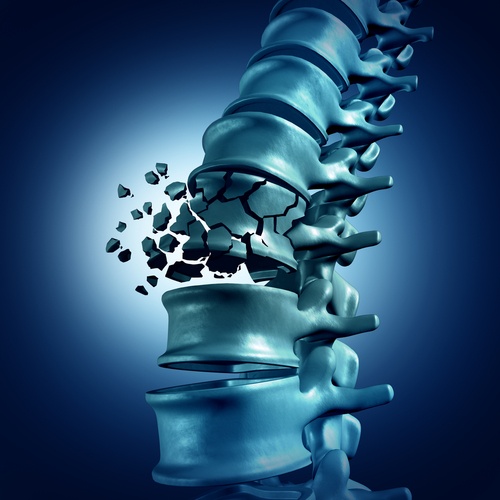
Osteoporosis was associated with a higher risk of adverse postoperative outcomes at 2-year follow-up for cervical fusion surgery, according to a study published in the January 1 issue of the Journal of the AAOS (JAAOS).
What Is Osteoporosis?
Osteoporosis is a common disease impacting nearly 200 million people globally. The disease is characterized by impaired bone mass and microarchitecture, leading to fragility fractures. Osteoporosis particularly affects older individuals and women and is the most common chronic metabolic bone disease.
Cervical Fusion in Osteoporosis Patients
With an aging population worldwide, there is a critical need to understand how osteoporosis impacts outcomes of procedures such as cervical spinal fusion, which is surgery that joins two or more vertebrae in the neck. According to the authors of the JAAOS study, “There are limited data regarding long-term outcomes in osteoporotic patients in the setting of ≥4-level cervical fusion.”
To evaluate the outcomes of fusion in osteoporotic patient, Bassel G. Diebo and colleagues utilized the New York State Statewide Planning and Research Cooperative System database to identify patients who underwent posterior or combined anterior-posterior ≥4-level cervical fusion between 2009 and 2011. Procedures were indicated for treatment of either cervical radiculopathy or myelopathy. Included patients had a minimum follow-up of 2 years.
The investigators compared the following factors between patients with and without osteoporosis: demographics, hospital-related parameters, medical/surgical complications, readmissions, and revisions. They also sought to identify independent predictors of outcomes in osteoporotic patients.
Overall, 2,604 patients were included in the study. One-hundred and thirty-six patients (5.2%) were osteoporotic. Patients with osteoporosis tended to be older (average age, 66.9 vs. 60.0 years, P<.001) and were more often female (75.7% vs. 36.2%, P<.001) and White (80.0% vs, 65.3%, P=.007) compared with the non-osteoporotic cohort. Charlson Comorbidity Index scores were similar between groups, meaning the comorbidity burden was comparable (P=.262). Additionally, total hospital costs and length of stay were similar between patients with and without osteoporosis (P=.181 and P=.109, respectively).
Cervical Fusion Outcomes and Complications
The investigators found that medical complications after cervical fusion were more common in patients with osteoporosis. Overall rates of medical complications were 41.9% vs. 29.4% in the osteoporotic and non-osteoporotic cohorts, respectively (P=.002). Rates of individual surgical complications were also higher in the osteoporosis group:
- implant-related complications: 8.1% vs. 2.9%, P<.001)
- non-union (2.9% vs. 0.7%, P=.006)
- central nervous system complications (1.5% vs. 0.2%, P=.012)
However, despite these differences, the overall rates of surgical complications were similar between patients with and without osteoporosis (14.0% vs. 9.2%, P=.070).
Regarding the risk of non-union, the authors wrote, “In this study, there was a >4-fold increase in nonunion for patients with osteoporosis compared with those without osteoporosis. … Nonunion has been implicated in poor long-term surgical outcomes such as those described in this study, likely because of instability and enhanced degeneration.”
Multivariate regression analysis found that osteoporosis was independently associated with greater risk of readmissions (odds ratio [OR]: 1.9, P=.003), medical complications (OR: 1.6, P=.021), and surgical complications (OR: 1.5, P=.03) at the 2-year follow-up. However, osteoporosis was not associated with greater risk of revision surgery (P=.367).
The authors noted that cervical fusion via the combined anterior-posterior approach was an independent predictor of 2-year surgical (OR: 1.6) and medical complications (OR: 1.5) compared with a posterior-only approach (P<.001); however, approach was not associated with changes in the risk of revision.
The authors acknowledged several limitations to the study, including the retrospective nature and reliance on accurate coding. “Degree of decrease in bone mineral density, time since diagnosis, dual-energy radiograph absorptiometry data, severity of cervical pathology, and the presence or absence of current management/treatment are all variables that could aid in the analysis but are not present in the database,” they added.
In summary, the authors wrote, “This study provides unique insight into the long-term outcomes after ≥4-level fusion of the cervical spine in the setting of osteoporosis, including increased rates of surgical complication, medical complication, and readmission. … These data should guide spine surgeons in the screening, preoperative optimization, and risk stratification of patients undergoing long fusion of the cervical spine.”







 © 2025 Mashup Media, LLC, a Formedics Property. All Rights Reserved.
© 2025 Mashup Media, LLC, a Formedics Property. All Rights Reserved.